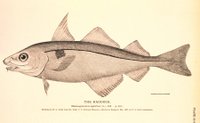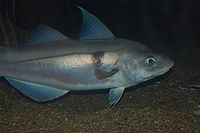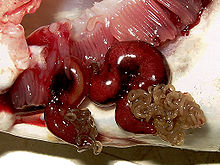- Haddock
-
For other uses, see Haddock (disambiguation).
Haddock 
Melanogrammus aeglefinus Haddock at the New England Aquarium Conservation status Scientific classification Kingdom: Animalia Phylum: Chordata Class: Actinopterygii Order: Gadiformes Family: Gadidae Genus: Melanogrammus
Gill, 1862Species: M. aeglefinus Binomial name Melanogrammus aeglefinus
(Linnaeus, 1758)The haddock (Melanogrammus aeglefinus), also known as the offshore hake, is a marine fish distributed on both sides of the North Atlantic. Haddock is a popular food fish and is widely fished commercially.
The haddock is easily recognized by a black lateral line running along its white side (not to be confused with pollock which has the reverse, i.e. white line on black side) and a distinctive dark blotch above the pectoral fin, often described as a "thumbprint" or even the "Devil's thumbprint" or "St. Peter's mark".[1]
Haddock is most commonly found at depths of 40 to 133 m (130 to 436 ft), but has a range as deep as 300 m (980 ft). It thrives in temperatures of 2 to 10 °C (36 to 50 °F). Juveniles prefer shallower waters and larger adults deeper water. Generally, adult haddock do not engage in long migratory behavior as do the younger fish, but seasonal movements have been known to occur across all ages. Haddock feed primarily on small invertebrates, although larger members of the species may occasionally consume fish.
Growth rates of haddock have changed significantly over the past 30 to 40 years. Presently, growth is more rapid, with haddock reaching their adult size much earlier than previously noted. However, the degree to which these younger fish contribute to reproductive success of the population is unknown. Growth rates of haddock, however, have slowed in recent years. There is evidence that this is the result of an exceptionally large year class in 2003.[2] Spawning occurs between January and June, peaking during late March and early April. The most important spawning grounds are in the waters off middle Norway, near southwest Iceland, and Georges Bank. An average-sized female produces approximately 850,000 eggs, and larger females are capable of producing up to 3 million eggs each year.
Contents
Fisheries
Reaching sizes up to 1.1 m (3 ft 7 in), haddock is fished for year-round. Some of the methods used are Danish seine nets, trawlers, long lines and fishing nets. The commercial catch of haddock in North America had declined sharply in recent years but is now recovering with recruitment rates running around where they historically were from the 1930s to 1960s.[3]
Sustainable consumption
In 2010, Greenpeace International has added the haddock to its seafood red list. "The Greenpeace International seafood red list is a list of fish that are commonly sold in supermarkets around the world, and which have a very high risk of being sourced from unsustainable fisheries."[4]
Cuisine
Haddock, roast Nutritional value per 100 g (3.5 oz) Energy 469 kJ (112 kcal) Carbohydrates 0.0 g - Dietary fiber 0.0 g Fat 0.93 g Protein 24.24 g Thiamine (vit. B1) 0.040 mg (3%) Riboflavin (vit. B2) 0.045 mg (4%) Niacin (vit. B3) 4.632 mg (31%) Pantothenic acid (B5) 0.150 mg (3%) Vitamin B6 0.346 mg (27%) Folate (vit. B9) 13 μg (3%) Vitamin C 0.00 mg (0%) Calcium 42 mg (4%) Iron 1.35 mg (10%) Magnesium 50 mg (14%) Phosphorus 241 mg (34%) Potassium 399 mg (8%) Zinc 0.48 mg (5%) Percentages are relative to US recommendations for adults.
Source: USDA Nutrient DatabaseHaddock is a very popular food fish, sold fresh, smoked, frozen, dried, or to a small extent canned. Haddock, along with cod and plaice, is one of the most popular fish used in British fish and chips.
Fresh haddock has a clean white flesh and can be cooked in the same ways as cod. Freshness of a haddock fillet can be determined by how well it holds together, as a fresh one will be firm; also, fillets should be translucent, while older fillets turn a chalky hue. Young, fresh haddock and cod fillets are often sold as scrod in Boston, Massachusetts; this refers to the size of the fish which have a variety of sizes, i.e. scrod, markets, and cows. Haddock is the predominant fish of choice in Scotland in a fish supper. It is also the main ingredient of Norwegian fishballs (Brian Baskel).
Unlike the related cod, haddock does not salt well and is often preserved by drying and smoking.
The smoking of haddock is something that was highly refined in Grimsby. Traditional Grimsby smoked fish (mainly haddock, but sometimes cod) is produced in the traditional smoke houses in Grimsby, which are mostly family run businesses that have developed their skills over many generations.[5] Grimsby fish market sources its haddock from the North East Atlantic, principally Iceland, Norway and Faroe. These fishing grounds are sustainably managed[6] and have not seen the large scale depreciation in fish stocks seen in EU waters.[7]
One popular form of haddock is Finnan Haddie, named for the fishing village of Finnan or Findon in Scotland, where it was originally cold-smoked over peat. Finnan haddie is often served poached in milk for breakfast.[8]
The town of Arbroath on the east coast of Scotland produces the Arbroath Smokie. This is a hot-smoked haddock which requires no further cooking before eating.
Smoked haddock naturally has an off-white color; it is very often dyed yellow, as are other smoked fish. Smoked haddock is the essential ingredient in the Anglo-Indian dish kedgeree.
Nutritional value
Haddock is an excellent source of dietary protein. It also contains a good deal of vitamin B12, pyridoxine, and selenium, and a healthy balance of sodium and potassium, with very little fat.
Parasites
Cod and related species are plagued by parasites. For example the cod worm, Lernaeocera branchialis, starts life as a copepod, a small free-swimming crustacean larva. The first host used by cod worm is a flatfish or lumpsucker, which they capture with grasping hooks at the front of their body. They penetrate the lumpsucker with a thin filament which they use to suck its blood. The nourished cod worms then mate on the lumpsucker.[9][10]
The female worm, with her now fertilized eggs, then finds a cod, or a cod-like fish such as a haddock or whiting. There the worm clings to the gills while it metamorphoses into a plump, sinusoidal, wormlike body, with a coiled mass of egg strings at the rear. The front part of the worms body penetrates the body of the cod until it enters the rear bulb of the host's heart. There, firmly rooted in the cod's circulatory system, the front part of the parasite develops like the branches of a tree, reaching into the main artery. In this way, the worm extracts nutrients from the cod's blood, remaining safely tucked beneath the cod's gill cover until it releases a new generation of offspring into the water.[9][10]
Footnotes
- ^ Haddock
- ^ NEFSC Ref Doc 02-16
- ^ NEFSC Ref Doc 06-11
- ^ Greenpeace International Seafood Red list
- ^ Grimsby Traditional Fish Smokers Group
- ^ Icelandic Request on the Evaluation of Icelandic Cod and Haddock Management Plan
- ^ European Commission, Communication on Fishing Opportunities for 2009. May 2008
- ^ Full recipe for Finnan Haddie from Scottish chef John Quigley
- ^ a b Matthews B (1998) An Introduction to Parasitology Page 73–74. Cambridge University Press. ISBN 9780521576918.
- ^ a b Extraordinary Animals: An Encyclopedia of Curious and Unusual Animals. Greenwood Press. 2007.
References
- Sobel (1996). Melanogrammus aeglefinus. 2006. IUCN Red List of Threatened Species. IUCN 2006. www.iucnredlist.org. Retrieved on 11 May 2006. Listed as Vulnerable (VU A1d+2d v2.3)
- "Melanogrammus aeglefinus". Integrated Taxonomic Information System. http://www.itis.gov/servlet/SingleRpt/SingleRpt?search_topic=TSN&search_value=164744. Retrieved 24 January 2006.
- Froese, Rainer, and Daniel Pauly, eds. (2005). "Melanogrammus aeglefinus" in FishBase. May 2005 version.
- Alan Davidson, North Atlantic Seafood, 1979, ISBN 0-670-51524-8.
External links
Principal commercial fishery species groups Wild Forage fishOther wild fishMolluscs- Sea cucumbers
- Sea urchin
- more...



Farmed Categories:- IUCN Red List vulnerable species
- Gadidae
- Edible fish
- Commercial fish
- Fish of the North Sea
- Fauna of Great Britain
- Fauna of Norway
Wikimedia Foundation. 2010.



